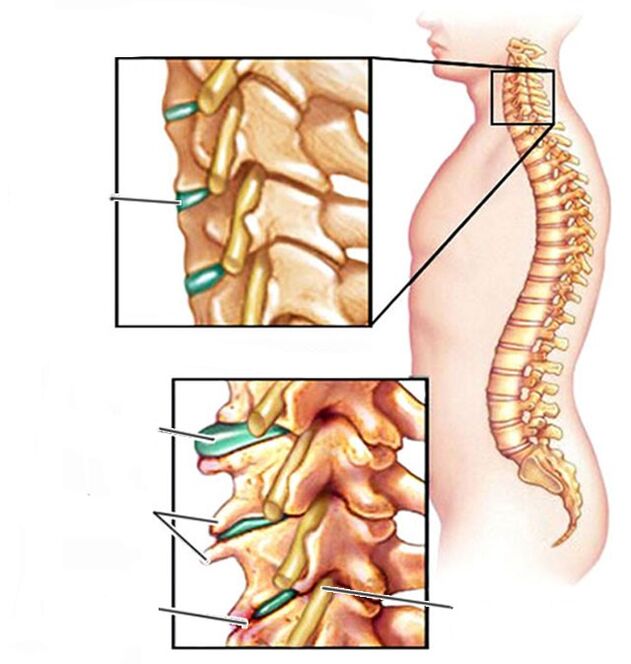The diagnosis of cervical osteochondrosis is made on the basis of simple studies - an X-ray. In order for the disease to recede, an integrated approach to the treatment of cervical osteochondrosis is needed.
In order for the disease to recede, an integrated approach to the treatment of cervical osteochondrosis is needed.
Why does cervical osteochondrosis occur?

The pain has several foci of localization: neck, head, shoulders. Weakened neck muscles provoke the development of osteochondrosis. Due to inappropriate behavior, passivity and adoption of unnatural positions, some neck muscles are constantly tense, others spend a lot of time at rest. The spine adapts to the irrational load at the cost of its health. In cervical osteochondrosis, the following changes are recorded:
- violation of blood and lymph flow;
- lack of connective tissue nutrition of intervertebral discs;
- instability of the position of the vertebral bodies in relation to each other.
Gradually, the structures of the vertebrae and discs are destroyed. This process is irreversible, so you should take care of your health in time and undergo treatment for the symptoms of cervical spine osteochondrosis immediately, without delay. Reasons also include:
- neck injuries;
- excess weight;
- connective tissue dysplasia;
- poor nutrition, insufficient water intake.
Osteochondrosis of the cervical spine: symptoms
Main signs (vertebral):
- Pain May be constant pulling or appear during periods after a static neck position, sleeping in an uncomfortable position. There is sharp pain that immobilizes the patient for a short time (lumbago);
- Torticollis or difficult movement. Sometimes it is so painful to turn or tilt the head that a person finds a comfortable position in which the pain is minimal and tries to stay in it;
- Muscle tension, feeling of stiffness, weight;
- Crunching of the beads when turning the head. Extravertebral symptoms of cervical osteochondrosis (involving nerves and surrounding tissues);
- Muscle inflammation;
- Headache, migraine, dizziness, sometimes with nausea and vomiting;
- Pain in the back of the head, increased intracranial pressure, feeling of a heavy head; such symptoms sometimes occur so clearly that the term "head osteochondrosis" has taken root among patients. Undoubtedly, headache is only a secondary manifestation of pathological changes in the skeletal system and it is correct to speak of the cervix, not of osteochondrosis of the head;
- Sensory dysfunction: hearing and vision impairment, speech, tinnitus due to lack of food in the brain;
- Pain in the bones of the collar, arms up to the palm;
- Tingling and chills in the neck and arms, sometimes numbness in the fingers;
- Restriction of the range of motion of the wings (preferably on one side).
Dangerous consequences of cervical osteochondrosis: treatment is mandatory!
If the degenerative changes do not stop, osteochondrosis can be added to the following:
- radicular pain due to compressed nerves arising from the spine;
- extensions and hernias, which compress the spinal cord and lead to complete paralysis;
- cervicocranialgia (cervical migraine, dystonic stage of vertebral artery syndrome);
- formation of osteophytes in vertebrae.
Methods for treating cervical osteochondrosis of the spine
It is impossible to cure this disease with medicine. You can remove the pain syndrome only with analgesics. But they always have side effects, so their use is recommended only in extreme cases. The symptoms and treatment of osteochondrosis of the cervical spine vary from patient to patient and require an individual approach.
Doctors have at their disposal a rich arsenal of advanced technologies; they can choose the most effective and efficient one. Effective in the treatment of cervical osteochondrosis and its manifestations:
- traction on the DRX robot - restores the correct position of the beads without the risk of damage;
- shock wave therapy - improves blood and lymph flow to the affected area, restores metabolic processes, relaxes muscles;
- interstitial electrical stimulation - fights the complications of osteochondrosis, relieves pain caused by inflammation of the oppressed nerve;
- HILT - laser therapy that relieves pain immediately.
The next stage in treating the symptoms of cervical osteochondrosis is restoring the blood supply, consolidating the correct position of the vertebrae. Rehabilitation can last several sessions and include physiotherapy, manual therapy and the use of modern equipment. The more accurately the patient follows the recommendations of specialists, the higher the effectiveness of the techniques. The final stage is in the area of patient responsibility:
- lifestyle and nutrition correction;
- regular exercise therapy;
- active life position and optimism.























